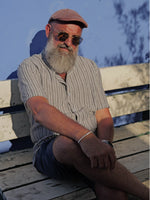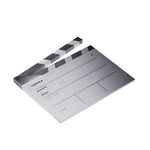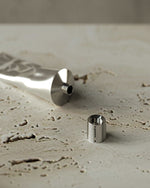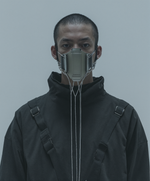20.09.23 in ambassadeurs
maxim flatry


Maxime FLATRY is a gallery owner, passionate about the Art Deco period. A trained ready-to-wear and jewelry stylist, he is opening his gallery dedicated to Decorative Arts of the first half of the 20th century in Saint-Germain-des-Prés in 2022.
How do you present yourself when you talk about yourself and your job?
I'm an antiques dealer, and I like that word. Often, I am told to say that I am a gallery owner, it is true that I present in a gallery, but I work as an antique dealer.
others think it's dusty, I think it's quite a magical word, “antique”.
a few words about your journey?
I come from a fashion background, I went to school at the Parisian couture union chamber. I finally switched to selling art deco furniture a little late. At first, I hid this past a little in fashion. I didn't take it on, strangely, for fear of not being sufficiently legitimate in this new activity in which people often ask which gallery I was in before, for example. and the more I think about it, the more I talk about it, and the more proud I am of these past experiences. they really gave me an eye and a taste for colors, for textures and for scenography. in the same way that you think about a look for a fashion show, I assemble the pieces that I present to create something coherent. and finally, these are environments that are very close. Moreover, the museum of decorative arts manages very well to draw parallels with furniture, art, jewelry or fashion.
and you designed jewelry, too?
I trained as a ready-to-wear designer, and I worked for an Australian fashion house which gave me the opportunity to design jewelry. and because I have always been passionate about design, they knew that by offering me this opportunity, I was getting a little closer, finally, to the creation of an object, something more designer, and therefore I I seized the opportunity straight away. It was then that I became a freelance jewelry stylist. it was crazy to be able to design something that could be placed on a table, like a vase, for example; something I can actually do today at the gallery.
How do you present yourself when you talk about yourself and your job?
I'm an antiques dealer, and I like that word. Often, I am told to say that I am a gallery owner, it is true that I present in a gallery, but I work as an antique dealer.
others think it's dusty, I think it's quite a magical word, “antique”.
a few words about your journey?
I come from a fashion background, I went to school at the Parisian couture union chamber. I finally switched to selling art deco furniture a little late. At first, I hid this past a little in fashion. I didn't take it on, strangely, for fear of not being sufficiently legitimate in this new activity in which people often ask which gallery I was in before, for example. and the more I think about it, the more I talk about it, and the more proud I am of these past experiences. they really gave me an eye and a taste for colors, for textures and for scenography. in the same way that you think about a look for a fashion show, I assemble the pieces that I present to create something coherent. and finally, these are environments that are very close. Moreover, the museum of decorative arts manages very well to draw parallels with furniture, art, jewelry or fashion.
and you designed jewelry, too?
I trained as a ready-to-wear designer, and I worked for an Australian fashion house which gave me the opportunity to design jewelry. and because I have always been passionate about design, they knew that by offering me this opportunity, I was getting a little closer, finally, to the creation of an object, something more designer, and therefore I I seized the opportunity straight away. It was then that I became a freelance jewelry stylist. it was crazy to be able to design something that could be placed on a table, like a vase, for example; something I can actually do today at the gallery.
“the real turning point towards the profession of gallery owner was made alongside Pierre Yovanovitch in particular. It was truly him who offered me the opportunity to choose this profession when I was still in between. »


When did the switch to the antiques dealer profession take place?
I have always bought furniture for myself, but it was only when I became a freelance stylist that I was able to really take the time to do it more seriously. I was indeed able to buy more intelligently, and think about being able to present pieces to others for resale. To my great surprise, I noticed that it worked well with professionals in the sector, who are also colleagues today. my first clients were merchants, but I also approached decorators and architects. I am thinking in particular of Pierre Yovanovitch, whom I consider today as a true mentor and as a friend. the real click happened at his side. I actually happened to accompany him to visit some of his clients, I was still a fashion stylist then. and upon arriving at one of them, Pierre asked me how I wanted to be introduced: jewelry stylist or expert in 20th century furniture. it was truly him who gave me the opportunity to choose this profession.
how do you identify and select artists or works?
what is certain is the emotion that this or that creation will give me. that's the first thing. there is also the fact that it must be linked to a field of knowledge. If I mainly defend the 20s and 30s, it is because it is the area that I admire the most. it is a fascinating meeting between two periods. when I present a piece, it's because I love it, and I also understand it. Incredible things happened in the 20th century. the art deco period is the root of modernity. I like to use this term often when I'm defending something, because that's where, ultimately, modern life began.
a piece that you are particularly proud to have had at the gallery? or a piece you would like to have?
the pieces that I will present next March at Tefaf Maastricht! I was indeed lucky to be selected and selected for this prestigious fair, and I have already worked very hard to have a worthy selection (I hope). I can't reveal too much yet, but it will be very 1925...
what nourishes you every day?
it’s a profession that is very two-headed. find the elements on one side, and present them on the other.
I obviously like staging in the gallery, that is to say putting the right light and the right harmony. for the piece of furniture to stand out as best as possible, there must be space around it, so that it can breathe and speak for itself.
and on the other hand, I deeply love hunting, finding an object, and then finding an attribution to it to enhance its value. restore it, and finally present it to the gallery to defend it as best as possible.
I have always bought furniture for myself, but it was only when I became a freelance stylist that I was able to really take the time to do it more seriously. I was indeed able to buy more intelligently, and think about being able to present pieces to others for resale. To my great surprise, I noticed that it worked well with professionals in the sector, who are also colleagues today. my first clients were merchants, but I also approached decorators and architects. I am thinking in particular of Pierre Yovanovitch, whom I consider today as a true mentor and as a friend. the real click happened at his side. I actually happened to accompany him to visit some of his clients, I was still a fashion stylist then. and upon arriving at one of them, Pierre asked me how I wanted to be introduced: jewelry stylist or expert in 20th century furniture. it was truly him who gave me the opportunity to choose this profession.
how do you identify and select artists or works?
what is certain is the emotion that this or that creation will give me. that's the first thing. there is also the fact that it must be linked to a field of knowledge. If I mainly defend the 20s and 30s, it is because it is the area that I admire the most. it is a fascinating meeting between two periods. when I present a piece, it's because I love it, and I also understand it. Incredible things happened in the 20th century. the art deco period is the root of modernity. I like to use this term often when I'm defending something, because that's where, ultimately, modern life began.
a piece that you are particularly proud to have had at the gallery? or a piece you would like to have?
the pieces that I will present next March at Tefaf Maastricht! I was indeed lucky to be selected and selected for this prestigious fair, and I have already worked very hard to have a worthy selection (I hope). I can't reveal too much yet, but it will be very 1925...
what nourishes you every day?
it’s a profession that is very two-headed. find the elements on one side, and present them on the other.
I obviously like staging in the gallery, that is to say putting the right light and the right harmony. for the piece of furniture to stand out as best as possible, there must be space around it, so that it can breathe and speak for itself.
and on the other hand, I deeply love hunting, finding an object, and then finding an attribution to it to enhance its value. restore it, and finally present it to the gallery to defend it as best as possible.
“Incredible things happened in the 20th century. the art deco period is the root of modernity. I like to use this term often when I'm defending something, because that's where, ultimately, modern life began. »

What compliment do you like to hear or hear again in your job?
in the art deco period, I like things that are not necessarily the most fashionable. I really like very early art deco from 1915. It's a somewhat forgotten period which is nevertheless very interesting. it's the beginning, we still find very round shapes. there is something very voluble, sometimes a little bold, a little clumsy. It's very exciting for me to present this furniture, which is not fashionable and which people are not interested in at first glance. and therefore receiving compliments on this type of creation that I have managed to highlight is very rewarding.
what was your biggest challenge?
the biggest challenge was being able to give myself the best birthday present for my 30th birthday: having my own gallery in Saint-Germain-des-Prés. to open it in June and in October, I was told that I was taken to Tefaf Maastricht.
and if you weren't a gallery owner, what job would you do?
I had a job before, and I think I was quite talented in clothing and jewelry design. I could have continued there, but for all that, no regrets, I'm very happy where I am. maybe in 10 years I will answer you something else!
do you have rituals in your life, your job?
sport, it's obvious, it's part of my routines, an almost daily ritual. when I miss a session, I am much less calibrated. I train 1 hour a day, six days a week. in reality, it is a moment that is extremely selfish and personal. I'm a little lost and ultimately more tired on the mornings when I haven't been able to go to the gym. the energy is clearly not the same.
in the art deco period, I like things that are not necessarily the most fashionable. I really like very early art deco from 1915. It's a somewhat forgotten period which is nevertheless very interesting. it's the beginning, we still find very round shapes. there is something very voluble, sometimes a little bold, a little clumsy. It's very exciting for me to present this furniture, which is not fashionable and which people are not interested in at first glance. and therefore receiving compliments on this type of creation that I have managed to highlight is very rewarding.
what was your biggest challenge?
the biggest challenge was being able to give myself the best birthday present for my 30th birthday: having my own gallery in Saint-Germain-des-Prés. to open it in June and in October, I was told that I was taken to Tefaf Maastricht.
and if you weren't a gallery owner, what job would you do?
I had a job before, and I think I was quite talented in clothing and jewelry design. I could have continued there, but for all that, no regrets, I'm very happy where I am. maybe in 10 years I will answer you something else!
do you have rituals in your life, your job?
sport, it's obvious, it's part of my routines, an almost daily ritual. when I miss a session, I am much less calibrated. I train 1 hour a day, six days a week. in reality, it is a moment that is extremely selfish and personal. I'm a little lost and ultimately more tired on the mornings when I haven't been able to go to the gym. the energy is clearly not the same.
“In the art deco period, I like things that are not necessarily the most fashionable. I really like very early art deco from 1915. It's a somewhat forgotten period which is nevertheless very interesting. it's the beginning, we still find very round shapes. »

what is important in your life?
without a doubt, the pride expressed to me by my parents and those close to me, upon seeing my name on the front of the gallery, has a lot of weight for me. whereas, on the contrary, I am quite embarrassed by it. If I could do this job without putting myself forward, I clearly would. but it's tricky in these professions not to embody your activity.
the creations le gramme and the brand, what does that inspire you?
I was a jewelry stylist before, so I think I have a pretty professional eye for jewelry. I really like the purity and timelessness of Le Gram’s creations. there is a parallel with the pieces that I present at the gallery. we find this same timelessness in these art deco creations. pieces that are still more than 100 years old. I'm thinking in particular of this pedestal table by Jean-Michel Frank which is just a line of metal. there is an obvious link, finally, with the bracelets that I particularly like from le gramme.
what is your relationship with jewelry?
I usually wear very little jewelry, apart from my le gram bracelets. I am also very demanding with jewelry.
a piece of jewelry is given to oneself or to someone. there has to be a story. it's something you don't change every day, like a piece of clothing. we keep it on us, on the skin directly. When my parents separated, my sister and I each took their wedding rings. I wore my father's for a long time around my neck with a gold chain that also belonged to him since he was 20. unfortunately, once I thought I had lost it when the necklace was ripped off. I didn't immediately realize it. I was lucky enough to find the ring on the ground, which was the most important thing in the end. Since then, I have worn it on my finger without ever taking it off.
what if le gramme was a work or a piece of furniture?
I have a solid silver bowl in the window right now that reminds me of le gramme. It's work that is anonymous today, but I do research to find an attribution, and that's also the work that I love. the object is aesthetically incredible in its simplicity, it is a modernist cup from the 1930s, with its half-lacquered foot.
without a doubt, the pride expressed to me by my parents and those close to me, upon seeing my name on the front of the gallery, has a lot of weight for me. whereas, on the contrary, I am quite embarrassed by it. If I could do this job without putting myself forward, I clearly would. but it's tricky in these professions not to embody your activity.
the creations le gramme and the brand, what does that inspire you?
I was a jewelry stylist before, so I think I have a pretty professional eye for jewelry. I really like the purity and timelessness of Le Gram’s creations. there is a parallel with the pieces that I present at the gallery. we find this same timelessness in these art deco creations. pieces that are still more than 100 years old. I'm thinking in particular of this pedestal table by Jean-Michel Frank which is just a line of metal. there is an obvious link, finally, with the bracelets that I particularly like from le gramme.
what is your relationship with jewelry?
I usually wear very little jewelry, apart from my le gram bracelets. I am also very demanding with jewelry.
a piece of jewelry is given to oneself or to someone. there has to be a story. it's something you don't change every day, like a piece of clothing. we keep it on us, on the skin directly. When my parents separated, my sister and I each took their wedding rings. I wore my father's for a long time around my neck with a gold chain that also belonged to him since he was 20. unfortunately, once I thought I had lost it when the necklace was ripped off. I didn't immediately realize it. I was lucky enough to find the ring on the ground, which was the most important thing in the end. Since then, I have worn it on my finger without ever taking it off.
what if le gramme was a work or a piece of furniture?
I have a solid silver bowl in the window right now that reminds me of le gramme. It's work that is anonymous today, but I do research to find an attribution, and that's also the work that I love. the object is aesthetically incredible in its simplicity, it is a modernist cup from the 1930s, with its half-lacquered foot.
“I really like the purity and timelessness of Le Gram’s creations. there is a parallel with the pieces that I present at the gallery. we find this same timelessness in these art deco creations. »

---accumulation---
bracelet_15g_silver-925_brush_smooth_jonc;bracelet_11g_silver-925_brosse_lisse_beads;bracelet_15g_silver-925_polished_smooth_jonc;necklace_1g_silver-925_yellow-gold-750_polished_smooth_entrelacs






